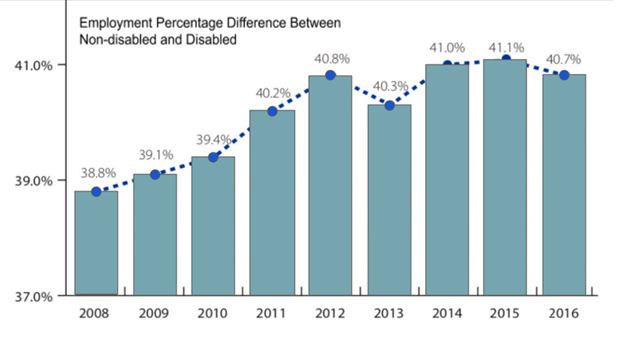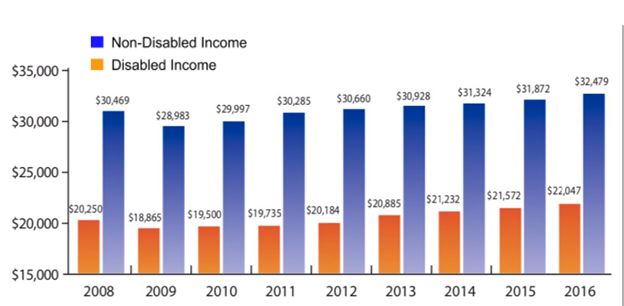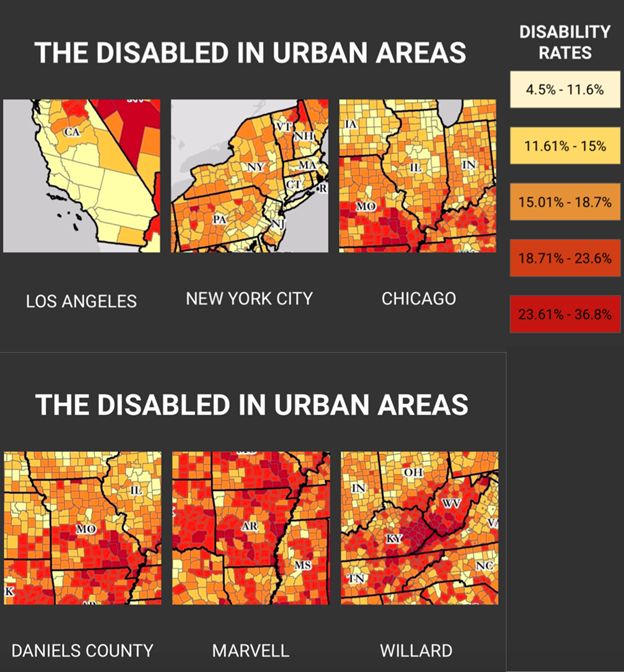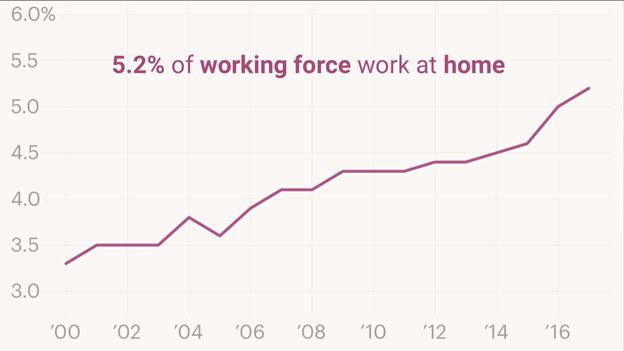[JSR] Special Feature - THE RELATIONSHIP BETWEEN THE DISABLED AND POVERTY

Employment Percentage Difference Between Non-disabled and Disabled Source: Graph created by Author, Seonghyeon Sean Lee

Income gaps between the Non-disabled and Disabled Source: Graph created by Author, Seonghyeon Sean Lee

Disability rates across different urban areas Source: Graphic created by Author, Seonghyeon Sean Lee

Increase of work-at-home personnel within the workforce Source: Graph created by Author, Seonghyeon Sean Lee

Seonghyeon Sean Lee, Grade 12 North Hollywood Highly Gifted Magnet School
However, even with the thorough and direct evidence clearly displaying the state of the disabled, both societal and governmental issues continue to deteriorate their quality of life.
Negligence by the US government has contributed to the consistent employment gap between the enabled and disabled, resulting in stagnant employment trends for the latter. While the past decade has seen a substantial number of cases illustrating the issue of unemployment in the disabled population, the US government has merely passed a single law to protect the employment needs of the physically disabled: the Americans with Disability Act (ADA). This law supposedly outlines the standards of protection that the disabled may receive in terms of employment, earnings, and workplace attitudes.
However, this act continues to display inconsistencies that harm the disabled rather than fulfill its original purpose. In the Title I section of the ADA, it states that if a physical disability is “too extreme” to the point that the person is unable to work, the ADA does not apply to them. Additionally, a nondisabled employee, who is perceived to have a “disability” in the eyes of the employer, is falsely protected by the ADA, a contradiction to the original purpose of the law. These circumstances diminish the credibility of the ADA and display the inefficacy of the law itself.
These inconsistencies in the ADA shed light on why the employment rates of the disabled have remained stagnant since its establishment in 1990. According to the Current Population Survey (CPS), a monthly sample survey regarding employment of 60,000 households, the 2017 unemployment rate for the disabled was 9.2%, rising steadily annually. These unemployment rates are similar to the unemployment rate of the disabled during the time period of the establishment of the ADA, which ranged from 8.7% to 8.9%.
Hence, the stationary unemployment rates from 1990 to 2017 not only verifies that the US government has remained blind to the issues regarding the physically disabled but also justifies the uselessness of the ADA in employment for the disabled, consequently inhibiting the development of the disabled stuck in states of poverty and troublesome conditions.
While the ADA promised reformation in societal views and the absence of racial discrimination in wages, the legislation has failed to protect the disabled from either. According to research reports done by Mark R. Montgomery in his article, “The Urban Transformation of the Developing World”, more people in different countries around the world are consistently relocating to urban cities and urban towns. Over 1.51 billion people in the world, or 87% of the world population, are relocating to urban cities, consequently causing an increase in urban development in undeveloped countries.
This is also true for developed countries, including the United States. However, this surge in population raises the costs of rent and overall costs of living, such as utility fees for water and electricity. According to the Yardi Matrix, which documents rent prices in the US, 93% of the largest 252 cities in the United States has seen average city rent price increase compared to the average of October 2017.
The general population of the US may be indifferent to this change, as the national annual average paycheck rounds to $32,479, but for the disabled, this negative modification of rent prices is detrimental, as their low annual wage of $22,047 does not allow for comfort or safety.
One simple and obvious solution is simply hiring the disabled. Many employers believe that hiring the disabled is charitable but contain no benefits towards the company. In response to this belief, the American Society of Safety Engineers completed a study on distribution centers in Walgreens, which resulted in fascinating statistics.
Not only did the disabled have a turnover rate that was 48 percent lower than that of the non-disabled population, but their medical costs were 67 percent lower and time-off expenses were 73 percent lower. Other studies showed significant benefits to hiring disabled employees, one of which allowed growth in customers as 92 percent of consumers favored companies with disabled employees.
Another solution is giving opportunities for the disabled to work at home. As the work-at-home rates continue to climb as technology becomes more advanced, it is possible to hire the disabled in positions that could utilize remote access to the workplace so that they may work at home. Currently in the United States, 3.7 million people, or 2.8% of the American workforce, work from home, rather than an office. However, because only 7% of employers allow for work-at-home, the growth rate has only been trudgingly increasing.
In order to support the disabled and help them rise out of poverty, it is crucial that many employers begin to consider work-at-home jobs for employees and continue to employ the disabled, as it proves to not only be beneficial for the disabled but also the employers.










with the Korea JoongAng Daily
To write comments, please log in to one of the accounts.
Standards Board Policy (0/250자)